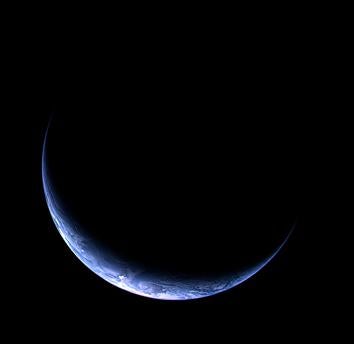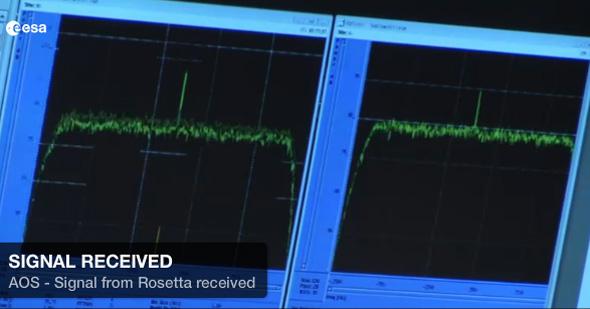European Space Agency engineers and scientists hung nervously over their monitors, awaiting a feeble radio signal from a space voyager over 800 million kilometers (500 million miles) away. As the minutes dragged on, the tension in the Space Operations Centre was palpable. All over the world, people on Twitter and other social media typed out words of encouragement …
… and then a thin, straight spike appeared among the noise of the cosmos. Rosetta had woken up, and was saying “Good morning!”
Rosetta is an ambitious mission: It will rendezvous with a comet, follow it through space around the Sun, and even send down a lander to the surface of the icy dirtball. Rosetta launched in 2004 and has used both Earth and Mars as gravitational boosters to get to its destination (at one point taking what may be my favorite picture of our home world of all time, and a similarly beautiful and astonishing photo of the Moon rising over the limb of the Earth).

Photo by ESA ©2009 MPS for OSIRIS Team MPS/UPD/LAM/IAA/RSSD/INTA/UPM/DASP/IDA
Rosetta’s target is the comet 67P/Churyumov-Gerasimenko, an ice ball with an estimated size of about four kilometers. It takes about 6.5 years to orbit the Sun, going well past the orbit of Jupiter and as far in toward the Sun as just outside the Earth’s orbit. We’ve only visited eight comets with spacecraft, and even then they’ve been flybys, where the probes have whizzed past the comets at high speed. This is the first time human probes will have stayed near the comet to examine it in detail.
And the lander … oh yes, the lander. Named Philae, it’s just under a meter across and has a mass of 100 kilograms (more than 200 pounds on Earth). It will touch down on the comet and shoot a harpoon into the ice to anchor itself (watch the movie Deep Impact to get an idea of how this works). It has 10 instruments on board to study the comet in situ, including a drill to study material under the surface and a camera that will return pictures that I will be very excited to see.
Rosetta was put into hibernation more than 30 months ago to preserve power as it swung away from the Sun. An internal alarm clock was set, and on Jan. 20, Rosetta woke up once again; it is now close enough to the Sun to get more juice through its solar panels. The single spike of energy in the photo above is Rosetta’s radio signal—the display shows frequencies, like a radio dial, and Rosetta’s signal is like a single station broadcasting, poking above the noise. It doesn’t look like much, perhaps, but it means everything.
Rosetta is ready for its close-up.

Photo by Photo by ESA, image by AOES Medialab
It’s only about 9 million kilometers (6 million miles) from the comet now. It will fire thrusters to match orbits more carefully, and in May it should come to relative rest just a few hundred meters away. It will set up shop, and in November will release Philae for its journey down. And then, for the first time in history, we’ll soft-land a remote probe onto a comet.
Think on that! Rosetta has traveled for hundreds of million of kilometers, has spent years sleeping away in the cold of deep space, and now that it has reawakened it will complete this phase of its mission: to extend the minds and grasp of humanity across the solar system, and to truly go where no one has gone before.
You can follow the Rosetta spacecraft on Twitter at @ESA_Rosetta.
